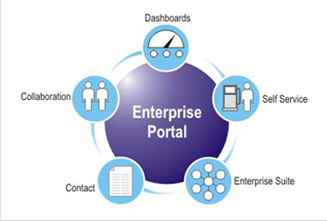Enterprise Portal: The Workplace of the Future

Enterprise portals are nothing new: In fact, they’ve been around since the late 1990s. Many important changes have occurred since the days when those first pre-packaged enterprise portals became available, and that’s refreshing news. Because old-fashioned software can be clunky and troublesome, newer, leaner versions are rapidly taking its place.
A Brief Guide to Enterprise Portals
If you’re new to the concept of enterprise portals, you’ll appreciate this brief, general definition:
An enterprise portal is a technological framework that is used to connect people while integrating essential information and processes. Like web portals, enterprise portals bridge gaps across organizational boundaries. The result is a single, consolidated access point that offers a desirable combination of convenience and security.
While past versions served as useful, unified access points that eased navigation between system components, outdated software is disorganized and complex, leading to user frustration and preventing smooth, effective, workflow.
Today’s enterprise portal software is designed with human needs, enhanced security, and enterprise mobility in mind. Customizable micro apps deliver a consumer-like look and feel, enhancing focus, boosting engagement, and speeding workflow via aggregated, personalized information feeds that offer employees an appealing, interactive experience similar to that of social media. Essential data is delivered with precision, preventing information overload and streamlining processes of all kinds.
Cost control is always a concern, but the modern enterprise portal delivers exceptional integration, so there is no need to replace legacy software. Microsoft Office 365, SAP ERP, Oracle EBS, Citrix XenMobile, and MySQL are just a handful of available integrations, with new options being added frequently.
How the Modern Portal Transforms the Workplace
Even when people know how to use the enterprise systems that are available to them, they have a tendency to avoid complicated, multi-step processes. The modern enterprise portal eliminates avoidance and encourages compliance in a few very important ways:
- Each person – from management down – receives a customized data feed populated with relevant information.
- Time-consuming searches are eliminated thanks to consolidated data mashups that combine information from multiple systems.
- Complex activities are consolidated into single-click workflows for faster, easier completion.
- Everyone has the opportunity to receive real-time insight: Customize the newsfeed to deliver company news, updates, activities, training, and more. Newsfeeds are personalized, so they are always relevant.
- Corporate intranets are transformed to destinations rather than simply serving as launchpads.
- Employee collaboration is easier, faster, and less time-consuming.
- Mobility is enhanced, enabling remote workers to complete tasks with the same level of efficiency as on-site employees.
Why Implement Digital Experience Portals?
Data silos do a fantastic job of housing information, but they often do more harm than good. More often than not, they can be held responsible for hampering accessibility, causing difficulty with decision-making, and slamming the brakes on productivity.
Siloed data happens for a variety of reasons. Whatever the cause, it often hurts businesses by preventing the appropriate people from easily accessing essential information. All too often, decisions are made without benefit of proper data analysis, efforts are duplicated, and there is a tendency for collaboration to decrease. Data left sitting in silos costs money – and often, it becomes degraded at the same time.
There’s another problem with the old way of doing business: Too many apps. When critical information is scattered, access becomes more difficult and employees are forced to waste time searching for what they need. Even simple tasks take longer, and this too leads to lost revenue. A Powering Productivity research survey found that inefficient processes lead to an astonishing 44 percent of wasted employee time – more than any other cause. Your business suffers as a result, and so does your customer experience.
A solid digital experience portal changes the game. Instead of struggling, employees find that the Facebook-like feed provides them with full access to everything they need to complete tasks of all kinds throughout the day. Customized micro apps break even the most complicated workflow into easily digested bites, simplify access to data, improve decision-making, and enhance productivity.
- Micro apps eliminate the need to open multiple windows in search of essential data.
- Basic tasks are easy to complete, minus confusing, time-consuming switches from one app to the next. Workflows of every kind are simplified.
- Information is organized automatically, making routine tasks faster and easier to complete.
- Existing business systems are integrated, so essential information makes its way to the right people at the right time.
- Some complicated workflows can be reconfigured into simpler tasks, and often, these tasks can be completed in as little as a single click.
Best of all, the modern enterprise portal can be accessed from any device the employee uses. Accessibility from different messenger systems and intranets is possible, too. Completely scalable to meet the needs of different-sized businesses, flexible enough to merge with existing infrastructure, and easily integrated with the systems your company has invested in.
The bottom line? When the employee experience is enhanced and simplified, your business benefits.








